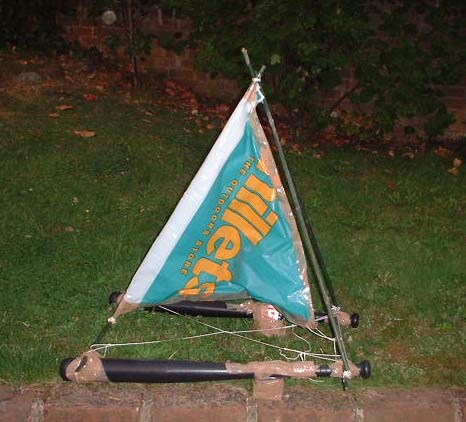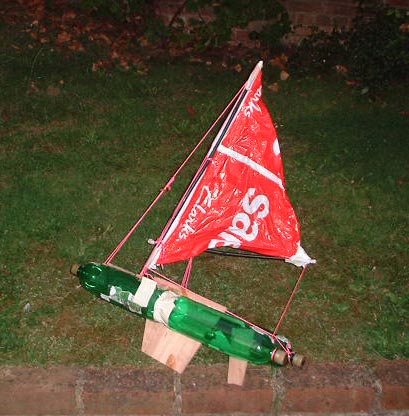Building Model Boats Using Household Rubbish
By Gavin
Atkin
For each of the past three years
my children and I have entered a competition at my local sailing
club to build a model sailing boat from rubbish. It's an idea
I'd suggest for almost any kind of boat enthusiast's event, so
long as it goes on long enough to build the boat! How about it
you messabouters? Making model sailing boats from rubbish can
be fun for both kids and grownups, it's a good learning exercise,
and you don't need a competition to make it fun.
At our sailing club the boats are
generally the result of some kind of collaboration between kids
and their parents, and our family's models certainly fit the pattern.
My children, nine-year-old Ewan and seven-year old Ella have all
sorts of views about the items we should use and how they should
fit together, but also insist that I think of ways of making the
boat they want use to work.
I'm glad to say that each one has
worked, but also that we've learned something new each year.
The first year
The first time we entered, I tracked
down some square-section guttering, cut two sections and sandwiched
a piece of waste ply between them. I then used gaffer tape to
make a double-ended bows and stern, and with odd bits of dowel,
drinking straws and plastic carrier bags made a carefully calculated
rig - the masts slipped neatly into holes created by slots I'd
cut into the sandwiched ply before assembly. We also gaffer-taped
taped fishing weights onto the bottom of the ply keel to give
the boat some righting moment in reasonably streamlined underwater
package.
The kids were delighted. The boat
looked impressive at about two and a half feet long, and had two
masts with equal sized white plastic bag sails. Initial trials
had it sailing upwind remarkably well with its long keel and good
sail area it would have stayed on the wind all day. I was particularly
pleased with this, for I had carefully calculated the centre of
effort of the rig and placed it exactly over the centre of lateral
resistance of the hull, and my calculations had obviously been
correct.
But our boat didn't win. It would
only sail hard on the wind, and that we found is not what is wanted
from a model sailing boat - it's too dull. A model boat is obviously
nothing like so fast on the wind as it is on a reach. It doesn't
do anything fun in the gusts. What's more, you can't easily make
it sail across to the other side of a pond, run round and send
it back to where it came from.
After the judging was over, I savagely
slashed the mainsail to about half its original size with a handy
pair of garden shears and launched it again - and this time it
flew off like a rocket. It was fast, it was directionally stable,
it was fun and Iím pretty sure that set up like this it
could have won the competition.
Although we'd lost, we did learn
something useful about the balance of free-sailing model boats,
and we also had a good design, even if we did not feel able to
use it again. I'm only sorry I haven't got a photo to show you.
The next year
The following year we completely
forgot to bring any rubbish with us, so were obliged to buy some.
It wasn't difficult: in a village corner shop we bought two completely
useless hollow plastic baseball bats (they would have bent on
hitting a softball and were entirely useless, except as rubbish),
some string and tape, a bottle of mineral water and some garden
canes. The bats made the hulls of a catamaran, and the cane made
cross members, an aft sloping mast attached to the fore cross
member and two further bits of cane supported the mast from aft
corners of the catamaran.

We drank the water and cut the
sides of the bottle into two strips, which we folded over the
bats and taped to make small keel-lets that could be moved up
and down along the length of the bats to control the balance of
the hull and rig. Once the keel-lets had been adjusted for a reach,
this weird looking entry (see picture above) nevertheless sailed
acceptably well. I like to think that it was a worthy contender,
even if it didnít win, and I'd suggest rubbish boat builders
might consider trying something like it, not least because itís
so quick and easy to make, and allows the adjustment these boats
need. The downsides are that they don't look much like sailing
boats and they have too much windage to make a good upwind sailers
- but as our first year's entry showed that doesn't matter.
This year
This year, however, we did a lot
better in the contest - in fact, we won. The latest entry benefited
from a little planning (this time we brought some rubbish and
some glue and tape!) and the kids, being a little older, had more
of an idea of what they wanted. It had to be a catamaran made
from four PET drinks bottles glued end to end. Scrap bits of ply
made cross members, and the mast (that cane again!) was held up
with some fluorescent pink builder's string. A single Bermudan
sail flew from the mast, and an off-centre keel slotted onto a
central cross-member, while a fixed 'rudder' was stuck to the
aft end of one of the hulls. The whole thing was balanced by eye
to sail on a reach, and initial tests revealed that the model
again sailed well and needed no adjustment. We fixed a slight
tendency to pitch pole by putting a little water in each of the
aft-most bottles and off she went on a reach while most of the
rest of the entries scuttled off downwind. (see picture below)

Next year?
I really don't know what will happen
next year. Perhaps they'll prevent us from entering. If they don't,
we may have to scratch our heads a lot harder to think of a low
tech easy and quick rubbish sailing boat project. Now, does anyone
remember reading a series of web pages about those model sailing
boats they race somewhere in Polynesia?
Gav
|

